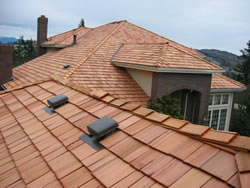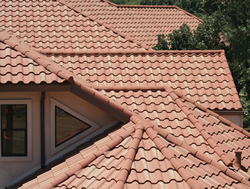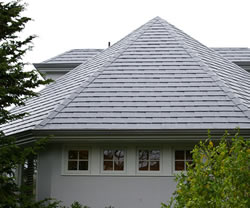
Figure 5 - Cedar shake roof
The difference between a cedar shake and a cedar shingle is their appearance. Cedar shingles are all the same size whereas cedar shakes are random sizes. The difference is in the aesthetics of the finished roof.
Cedar shingle or shake roofs can easily last for more than 50 years providing they are looked after properly. The finished roof provides good insulation with a very lightweight material. Cedar roofs are not maintenance free.
The most important disadvantages of cedar roofs are the fire rating. Although some manufacturers are impregnating the cedar with fire retardant chemicals many insurance companies have an increased premium for homes with cedar roofs.
The use of cedar as your roofing material does qualify as an environmentally friendly product and it is a renewable resource.
Cedar shakes and shingles can be installed by a competent home handyman. It is important to note that cedar shakes and shingles come in a variety of grades and it is important that you understand what grade of shingle or shake you are purchasing and its characteristics.
Clay Tile

Figure 6 - Clay tile roof
Clay tile roofing, as shown in Figure 6, has been around for centuries. However, new technologies have enhanced the characteristics of clay tile roofing materials. Clay tile is an excellent choice, from an aesthetic point of view for houses that are designed with a southwestern, Italian or Spanish motif.
Clay tile will outlast the sheathing that it is mounted on, making it a very durable roofing material. It is does not fade, is basically impervious to insect attack and will not rot. Clay tile is also fire resistant.
The biggest disadvantage is in the installation of clay tile roofs. Cutting and sealing the tiles around flues, vents, skylights and chimneys require a good deal of expertise. Installing a clay tile roof is not generally considered a home handyman project. Secondarily, clay tile is a heavy material and it may be necessary to add structural support in order to support the roof.
Slate

Figure 7 - Slate roof
Slate is a natural stone that was very popular in Europe for many centuries and is now being installed on upscale homes in North America, as shown in Figure 7.
Slate is a heavy material and in a similar manner to clay tile roofs, the roof structure may have to be reinforced to support the weight of the tiles.
Being a natural stone, slate is impervious to rot, does not burn nor will it attract mold or mildew.
Installation requires a lot of expertise and finding a competent contractor to install a slate roof is one of the biggest problems associated with the installation.
There is a level of class when viewing the outside of a home that has a slate roof.
